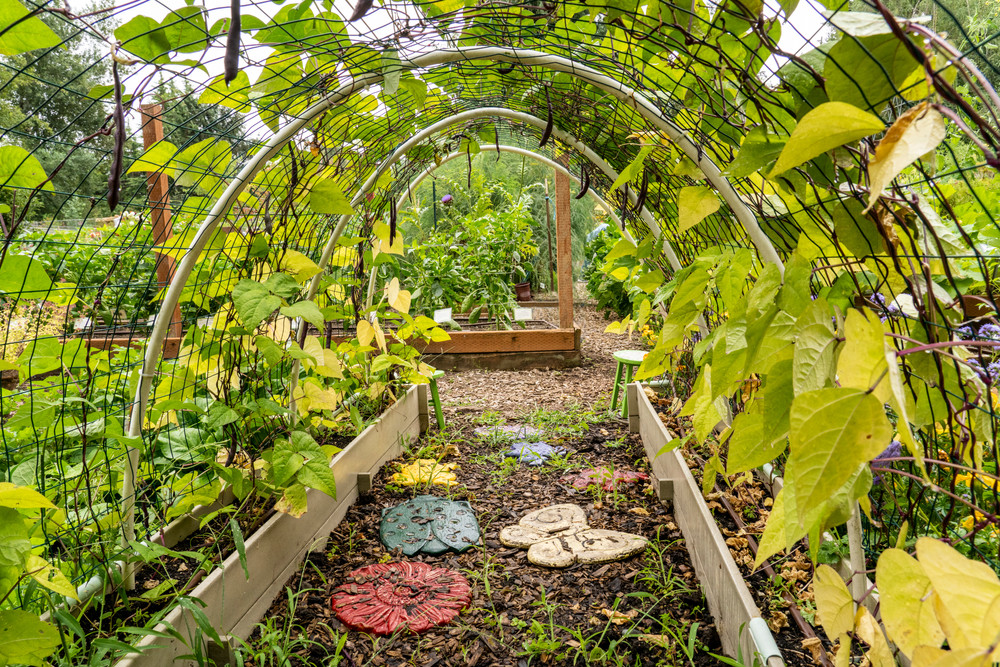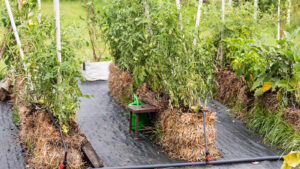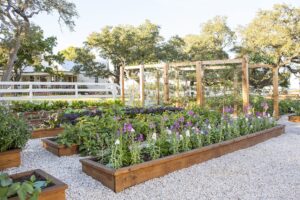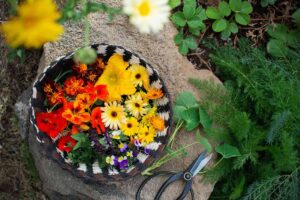Transform Your Landscape with a Garden Arch: The Ultimate Guide to Selection, Installation, and Styling
Garden arches stand as elegant focal points in any landscape, creating vertical interest and defining transitions between garden rooms. Whether you’re looking for a structure to support climbing roses, a dramatic entrance to a vegetable garden, or simply a decorative element, the right garden arch can elevate your outdoor space from ordinary to extraordinary. This comprehensive guide will help you navigate the selection process, provide installation expertise, and offer creative styling ideas to make your garden arch a standout feature.
Why Your Garden Needs an Arch
Garden arches serve multiple purposes beyond mere decoration. These versatile structures create a sense of journey and discovery in your landscape by framing views and pathways. They provide essential vertical support for climbing plants, allowing you to grow upward when ground space is limited. Most importantly, arches establish visual transitions between different garden zones, helping to organize your landscape into distinct “rooms” with their own character.
Garden arches date back centuries, appearing in formal European gardens as early as the 16th century. These architectural elements were initially crafted from bent willow or hazel branches before evolving into the more permanent metal and wood structures we see today. Their enduring popularity speaks to their practical and aesthetic value in garden design.
Types of Garden Arches
The market offers a diverse range of arch styles to complement any garden aesthetic:
Classical Metal Arches
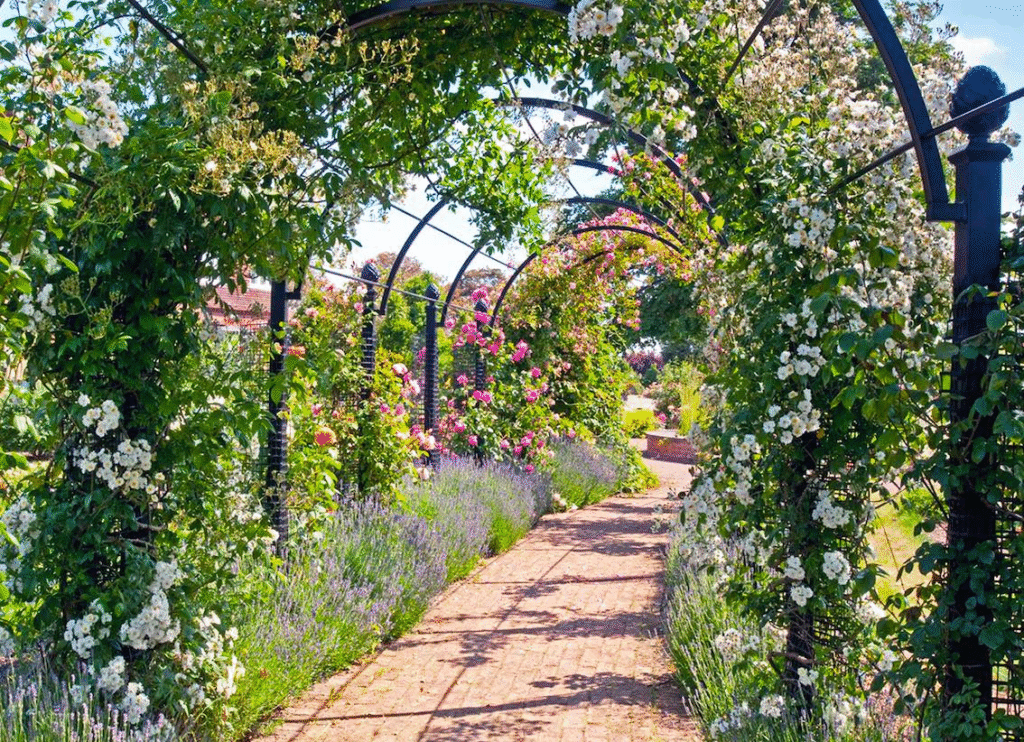
Metal arches, typically crafted from wrought iron, steel, or aluminum, offer exceptional durability and a timeless aesthetic. These structures provide robust support for mature climbing plants and withstand harsh weather conditions. While premium wrought iron designs command higher prices, powder-coated steel alternatives offer similar visual appeal at more accessible price points.
Wooden Garden Arches
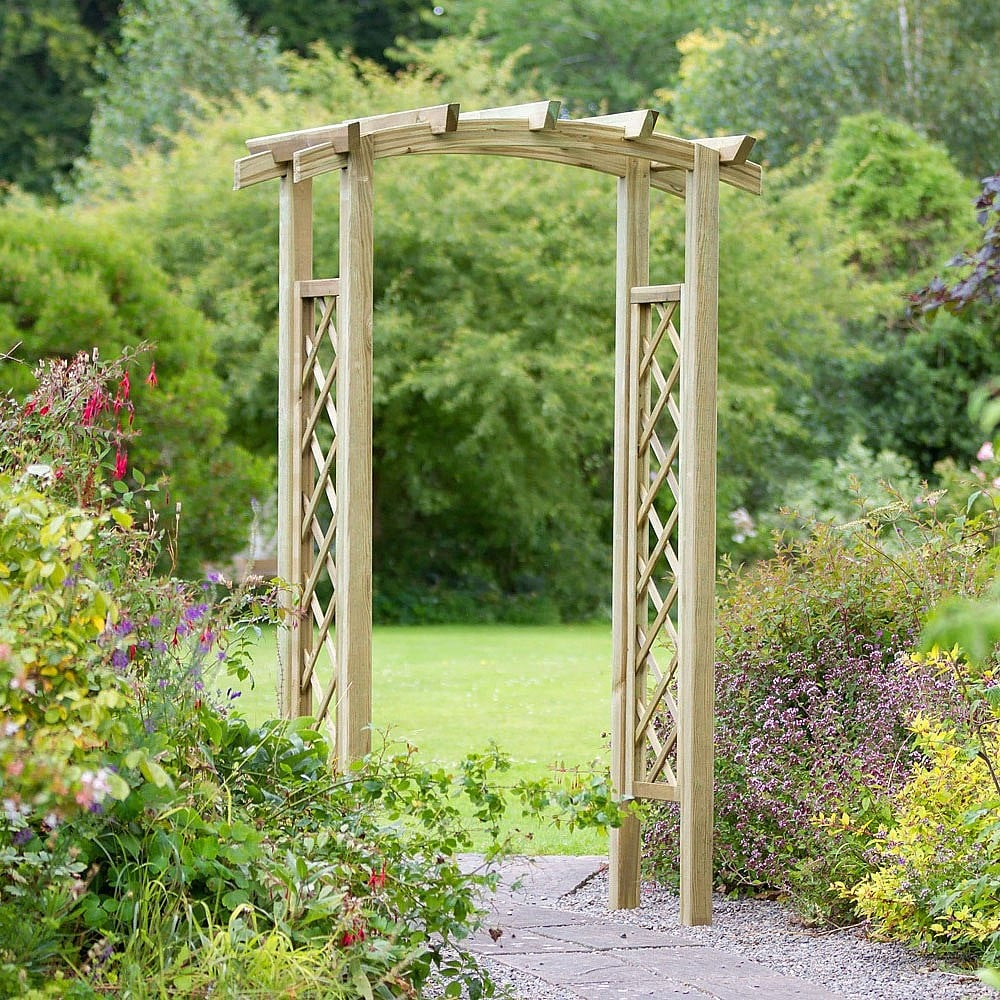
Wooden arches bring natural warmth to the garden landscape. Cedar, redwood, and pressure-treated pine represent popular choices for their natural resistance to decay. These structures complement cottage gardens, traditional landscapes, and rustic settings particularly well. Many wooden arches feature lattice panels that provide ideal support for climbing plants while creating dappled shade.
Unusual Garden Arches
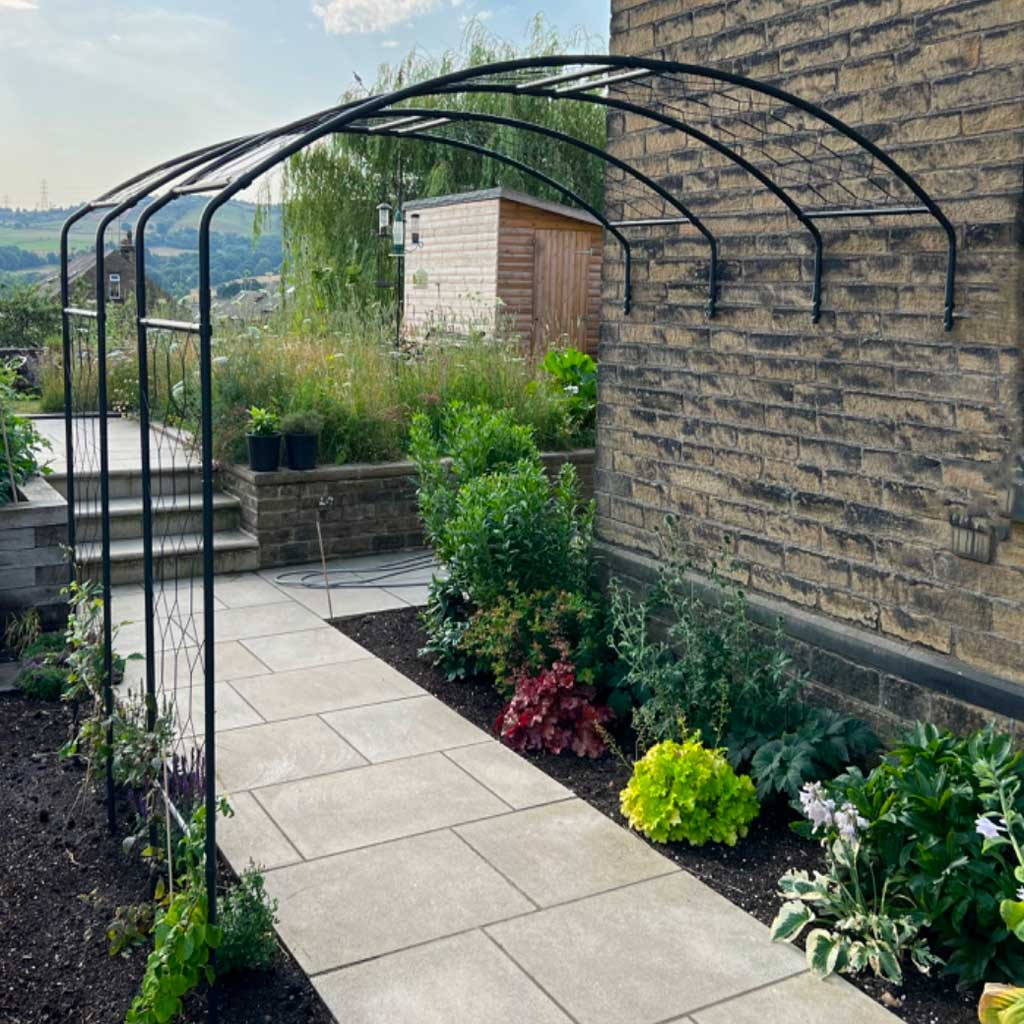
For gardeners seeking something beyond conventional designs, the market offers innovative alternatives:
- Repurposed Material Arches: Creative structures fashioned from salvaged windows, doors, or industrial materials
- Living Willow Arches: Woven living willow branches that root and grow, forming natural, evolving structures
- Geometric Modern Designs: Contemporary arches featuring clean lines and unexpected angles
- Asian-Inspired Torii Gates: Distinctive horizontal beam structures influenced by Japanese garden traditions
- Gothic Cathedral Arches: Dramatic pointed arches reminiscent of medieval architecture
Unusual garden arch designs have gained significant popularity in recent years as gardeners seek to express individual style. These unique structures often become conversation pieces and can significantly increase property value when thoughtfully integrated into the landscape.
Key Considerations Before Purchase
Before investing in a garden arch, evaluate these essential factors to ensure you select the right structure for your needs:
Size and Scale
Garden arches range from intimate structures (about 3-4 feet wide) to grand entrances spanning 8 feet or more. The appropriate size depends on your garden scale and intended use. For standard garden paths, a width of 4-5 feet provides comfortable passage, while height should allow at least 7 feet of clearance for walking beneath. Consider the mature size of climbing plants when determining arch dimensions, as vigorous varieties require substantial support.
Material Durability
Your local climate significantly influences material selection:
- Hot, dry climates: Metal arches without proper coating may become too hot for plant growth
- Coastal environments: Choose marine-grade stainless steel, aluminum, or specially treated wood to resist salt corrosion
- Cold, snowy regions: Select structures rated to support snow loads without buckling
- High-wind areas: Ensure secure anchoring capabilities and wind-resistant designs
Weight Capacity
Different arch designs offer varying load-bearing capabilities, a critical factor when planning for mature climbing plants. Lightweight budget arches may support annual vines like morning glory or sweet peas but prove inadequate for woody climbers such as wisteria or climbing roses. Heavy-duty garden arches typically feature thicker metal tubing (12-14 gauge steel) or reinforced joints designed to support plant loads exceeding 100 pounds. These structural elements prevent bending or collapse under the weight of mature plants and adverse weather conditions.
Assembly Requirements
Garden arches range from simple snap-together designs to complex structures requiring professional installation. Review assembly instructions before purchase, noting required tools and estimated completion time. Some wooden arches benefit from pre-assembly weatherproofing treatments, while metal structures may need concrete footings for stability in soft ground.
Finding the Best Value: Heavy-Duty Garden Arches on Clearance
Quality garden arches represent a significant investment, but savvy shoppers can find exceptional value through various channels:
Seasonal Clearance Opportunities
Garden retailers typically offer clearance sales during specific periods:
- End-of-season clearances: Late summer through fall (August-October)
- Inventory reduction sales: January-February before new stock arrives
- Holiday weekend promotions: Memorial Day, July 4th, and Labor Day sales
During these clearance periods, heavy-duty garden arches often sell at 30-50% below regular retail prices. Garden centers must clear inventory before the next season’s arrivals, creating excellent opportunities for value-conscious shoppers. Sign up for email notifications from local garden centers to receive alerts about upcoming sales.
Where to Find Garden Arch Lowest Price Clearance
Strategic shopping can yield substantial savings:
- Big-box garden departments: Home improvement retailers like Home Depot, Lowe’s, and Menards offer end-of-season clearances on remaining garden structures.
- Local garden centers: Independent nurseries often clear display models at significant discounts.
- Online marketplaces: Wayfair, Amazon, and Overstock frequently offer flash sales and clearance sections.
- Manufacturer direct sales: Companies like Gardman, Plow & Hearth, and Achla Designs provide occasional factory-direct clearance events.
When evaluating clearance arches, inspect for all hardware components and structural integrity. Minor cosmetic issues on clearance items can often be remedied with touch-up paint or simple repairs, resulting in significant savings without compromising quality.
Finding “Garden Arch Near Me”: Local Sourcing Advantages
While online shopping offers convenience, sourcing locally provides distinct advantages:
Benefits of Local Purchase
- Immediate availability: Take home your arch the same day
- Reduced shipping costs: Avoid freight charges on large structures
- Inspection opportunity: Examine construction quality firsthand
- Assembly advice: Receive personalized guidance from knowledgeable staff
- Local design compatibility: Select styles appropriate for regional architecture
How to Locate Local Suppliers
Beyond standard garden centers, explore these specialized sources:
- Architectural salvage yards: For unique, repurposed arches with character
- Custom metalworkers: For bespoke designs tailored to your specifications
- Landscape design firms: For professional-grade structures as part of comprehensive garden plans
- Craft fairs and garden shows: For artisan-made wooden or metal arches
Local garden clubs and horticultural societies often maintain lists of reputable suppliers and may offer member discounts at participating retailers. These organizations frequently host annual plant sales where specialty garden structure vendors showcase their products. These events provide excellent opportunities to view multiple options and compare prices within your community.
Installation Best Practices
Proper installation ensures your garden arch remains stable and visually appealing for years to come:
Site Preparation
- Mark the exact position using stakes and string to visualize the arch in place
- Check for underground utilities before digging post holes
- Ensure level ground or compensate for slopes during installation
- Consider sun orientation for optimal plant growth
- Evaluate sight lines from key viewing positions
Securing Your Arch
Different surfaces require specific anchoring approaches:
- Soil installation: Dig holes 18-24 inches deep, place arch legs, and backfill with concrete
- Deck mounting: Use appropriate brackets and rust-resistant hardware
- Paver pathways: Remove pavers, install arch in soil beneath, then replace pavers around legs
- Concrete surfaces: Use expansion bolts or specialized concrete anchors
For maximum stability in heavy-duty garden arches, professional installers recommend extending metal legs into concrete footings that reach below the frost line in cold climates. This installation method prevents frost heave damage and ensures the structure can support mature climbing plants.
Weatherproofing Considerations
Extend your arch’s lifespan with these protective measures:
- Apply additional sealant to wooden components even if pre-treated
- Consider adding drainage holes at the base of metal arch legs to prevent water accumulation
- Install arch slightly off-center on concrete footings to allow water runoff
- Apply anti-rust treatment to any scratched areas on metal arches before they begin to corrode
Styling Your Garden Arch
Transform your functional structure into a breathtaking focal point with these design approaches:
Plant Selection for Quick Coverage
For rapid results, these vigorous climbers establish quickly:
- Annual vines: Morning glory, hyacinth bean, black-eyed Susan vine
- Fast-growing perennials: Silver lace vine, climbing nasturtium, cup-and-saucer vine
- Hardy climbers: Clematis ‘Jackmanii’, American bittersweet, hardy kiwi
Creating Four-Season Interest
Maintain visual appeal throughout the year with these strategies:
- Evergreen foundation: Plant climbing evergreens like Baltic ivy for winter structure
- Succession planting: Combine spring-flowering clematis with late-summer blooming roses
- Berry producers: Incorporate plants like American bittersweet for fall and winter color
- Structural elements: Add solar lighting, decorative finials, or weather-resistant ornaments
Design Inspiration
These themed approaches provide starting points for your creative vision:
- Cottage Garden Arch: Combine climbing roses with clematis for romantic abundance
- Edible Entrance: Frame a vegetable garden with productive cucumber, bean, or grape vines
- Butterfly Gateway: Plant passion flower, honeysuckle, and other butterfly-attracting climbers
- Fragrant Passage: Select aromatic climbers like jasmine, roses, and sweet peas
- Formal Definition: Use precisely trimmed ivy or espaliered fruit trees for architectural elegance
Maintenance Essentials
Protect your investment with proper ongoing care:
Structural Maintenance
- Annual inspection: Check for loose hardware, wood rot, or metal corrosion
- Joint tightening: Secure any loose connections before the growing season
- Surface treatment: Apply fresh sealant or paint every 2-3 years
- Winter preparation: Remove excessive plant weight before snow season in cold climates
Plant Management
- Strategic pruning: Train plants to grow evenly across the structure
- Weight distribution: Prevent one-sided growth that could unbalance the arch
- Attachment systems: Use soft plant ties that won’t damage stems or arch materials
- Renewal management: Cut back aggressive climbers to prevent structural damage
Beyond Basic Arches: Creative Applications
Explore these innovative uses for garden arches:
Garden Arch as Outdoor Room Creator
Multiple arches can define outdoor living spaces:
- Dining canopies: Create natural ceilings for outdoor dining areas
- Reading retreats: Establish secluded spaces for relaxation
- Children’s play zones: Design whimsical entrances to play areas
- Meditation gardens: Frame contemplative spaces with graceful arches
Functional Applications
Garden arches serve practical purposes beyond aesthetics:
- Vegetable supports: Train squash, beans, and other edibles vertically
- Harvest helpers: Position arches where they facilitate easy picking
- Privacy screens: Use multiple arches with dense climbers as living walls
- Climate control: Create cooling shade corridors in hot climates
Case Study: Garden Arch Transformation
The Johnson family transformed their suburban backyard using a series of clearance-priced metal arches to create a journey through previously undefined space. By installing five matching arches along a curved pathway, they established distinct garden rooms for dining, children’s play, and quiet relaxation. The heavy-duty structures, purchased during an end-of-season sale, provided support for a combination of clematis, climbing roses, and annual sweet peas, creating year-round interest and exceptional privacy from neighboring properties.
Conclusion: Investing in Garden Beauty
A well-chosen garden arch represents more than a mere decorative element—it’s a transformative structure that defines space, supports plant life, and creates memorable garden moments. Whether you select a heavy-duty clearance find, an unusual artistic creation, or a locally sourced custom design, your garden arch will likely become a central feature that shapes your landscape’s character for years to come.
By considering proper scale, material durability, and installation requirements, you’ll select a structure that provides lasting value. Through creative styling and proper maintenance, your garden arch will evolve into a signature element that distinguishes your garden and creates a lasting impression on visitors and family alike.
